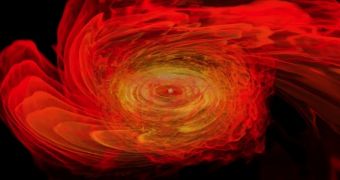On March 17, experts operating the Background Imaging of Cosmic Extragalactic Polarization 2 (BICEP2) experiment at the South Pole announced the accurate identification of gravitational waves, distortions in spacetime originating from highly-energetic phenomena in the Universe. In 2015, a new ground-based twin detector will be inaugurated to confirm the existence of such waves in more detail.
The Laser Interferometer Gravitational-Wave Observatories (LIGO) consists of two installations, the LIGO Livingston Observatory in Livingston, Louisiana, and the LIGO Hanford Observatory at the DOE Hanford Site near Richland, Washington. The facilities are 3,002 kilometers (1,865 miles) apart, a distance large enough to detect the massive gravitational waves.
Each of the installations has an L-shaped arm, which fires lasers towards its counterpart thousands of kilometers away. The passing of a gravitational wave between the two installations would produce extremely small variations in the length of one beam compared to the other. Physicists in charge of the experiment will monitor the exact length of the beams with extreme precision.
The experiment that will begin in 2015 is an improved version of the older LIGO (which operated between 2002 and 2010) and is called Advanced LIGO. It is operated by the international LIGO Scientific Collaboration (LSC), which includes researchers from the Massachusetts Institute of Technology (MIT) and the California Institute of Technology (Caltech).
Experts at the US National Science Foundation (NSF), which sponsors the LSC, say that the new facility is expected to be sensitive enough to make daily observations of gravitational waves. Its laser-based approach differs widely from the one employed by the BICEP2 experiment, which searches for B-mode signatures in the cosmic microwave background, the relic light left by the Big Bang.
“The actual change in the relative arm lengths of the interferometer [LIGO] due to the passage of a gravitational wave is incredibly small. It's just 10 to the minus 19 meters difference in one arm relative to the other, that's one ten-thousandth the size of a proton,” said LIGO lead scientist Michael Landry during an interview for a new documentary, to premiere on Space today.
Gravitational waves are believed to be produced by very intense and powerful events in the Universe, such as the collision of two massive stars, or a star and a neutron star, or a star and a black hole. Binary systems where one of the members is either a neutron star or a black hole may also generate these distortions in the fabric of spacetime.
“The plan is to take data for the first time in 2015. We know that they will not be at the best sensitivity they could have, but our estimate is that they will be at least two, perhaps three times better than initial LIGO detectors were,” explains Louisiana State University expert Gabriela Gonzalez.
“It will be worth taking at least a few months of data, we estimate three months […] It's not likely we will see something,” adds the expert, a professor of physics and astronomy at LSU and a member of the LIGO science team.

 14 DAY TRIAL //
14 DAY TRIAL //